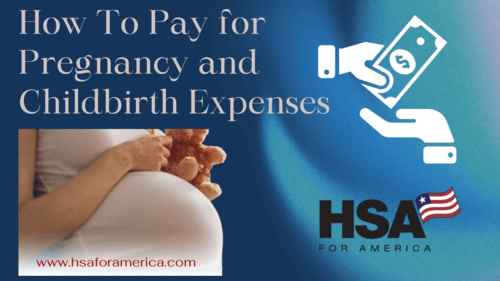Pregnancy is an incredible journey. But it can be expensive.
Nationwide, without insurance, the average medical cost of pregnancy, childbirth, and postpartum care is now over $18,865 as of 2023.

For Cesarean sections, the average cost runs $26,280.
Remember, receiving early prenatal care prevents poor health outcomes for you and your baby. Do not wait to receive prenatal care from your chosen provider.
This comprehensive guide will walk you through the various options to manage pregnancy expenses without compromising on care.
Even with insurance, women and couples still face thousands of dollars in out-of-pocket costs, in the form of deductibles, co-pays, and coinsurance.
And that’s not counting the staggering cost of monthly health insurance premiums, which are rising yet again this year.
If you are pregnant or may become pregnant this year, here are some tips for saving money on healthcare costs during and after pregnancy and childbirth.
Health Insurance Tips
Health insurance is expensive. But it does help pay for costs that most people would have trouble paying for out of their own pockets.
Traditional health insurance is not the only way to pay for pregnancy and childbirth costs. But it does have some advantages:
- Purchasing power. Traditional health insurance companies can write very large checks, if needed, for difficult pregnancies and deliveries, and for NICU care for premature babies and those with other severe medical problems.
- Guaranteed acceptance. Traditional health insurance plans must take you on, even if you are already pregnant, provided you enroll and pay premiums during the annual open enrollment period (November 1st through January 15th in most states), or during a special enrollment period. Similarly, employer-sponsored group plans must also accept you during your initial eligibility or employers’ open enrollment period, even if you enroll mid-pregnancy.
- Affordable Care Act subsidies. Depending on your income and the size of your household, you may qualify for a subsidy to help make your health insurance premiums more affordable. This can be a significant factor if you have a low-to-moderate income (typically up to around 400% of the federal poverty level).
To qualify for subsidies, you must purchase a qualifying policy that is listed on your state’s health insurance Marketplace or the federal Marketplace. However, you can and should use an expert Personal Benefits Manager or independent insurance broker to help you research and enroll. It’s free, and can save loads of time!
Note: With traditional insurance products and workplace group plans, You might have limited flexibility in choosing your healthcare providers.
Compare Pricing on the Best Insurance Plans Available
Health Sharing Programs
Health sharing programs are a viable option for many women seeking prenatal care.
With flexibility in provider choice and low monthly expenses compared to unsubsidized traditional health insurance, health sharing can be a terrific option.
Most health share plans limit sharing benefits for women who are already mid-pregnancy. And because many health share plans are religious ministries, some limit benefits for unmarried women.
For this reason, health sharing tends to work best for married women who are not currently pregnant but plan to start a family in the future, and for women or families who don’t qualify for a large subsidy under the Affordable Care Act.
Note: Most ACA-qualified traditional health insurance products available through government exchanges are HMOs and PPOs, which limit your freedom to choose your doctor.
In contrast, health sharing plans grant you much more freedom to use doctors, hospitals, and other providers of your choice.
Read More: The Best Health Sharing Plans for Maternity
Q – Do health sharing programs share costs for prenatal visits, labor, and postnatal care?
Yes, many health sharing programs share costs for prenatal, labor, and postnatal care expenses.
Specifics vary from plan to plan, though, so check plan guidelines, or contact a Personal Benefits Advisor.
Q – Are there waiting periods before I can use health sharing for maternity coverage?
Some health sharing programs have waiting periods for maternity coverage.
Be sure to choose one that aligns with your due date. Check plan guidelines for specifics, or contact a Personal Benefits Manager.
Q – Can I choose my healthcare provider and hospital when using health sharing for maternity care?
Most health sharing programs usually allow you to choose your healthcare provider and hospital.
However, if your chosen provider charges much more than is reasonable and customary in your area, you may need to help pay the difference in costs.
Q – Are childbirth classes and maternity education covered under health sharing?
Health sharing may not cover childbirth classes or education, so you might need to pay for these separately.
Health Sharing Advantages:
- Cost-effective: Health sharing programs often come with lower monthly contributions compared to traditional insurance premiums.
- Flexible provider choice: With health sharing, you have the freedom to choose your healthcare providers.
- Pregnancy coverage: These programs typically include coverage for pregnancy-related expenses.
- Expectant mothers may save up to 50% compared to traditional non-subsidized health insurance.
- Health sharing members can often qualify for discounts as cash payers. Ask your providers about their best available discounted rates for uninsured/cash pay patients.
Health Sharing Disadvantages:
- Health sharing plans generally impose waiting periods before costs related to pre-existing conditions become fully shareable.
- Health sharing plans may have caps on the amount they will share for natural and cesarean births and other costs. These are normally more than ample to cover typical and even difficult pregnancies, but may not be sufficient for rare and extreme cases.
- May require adherence to behavioral guidelines: Health sharing programs are often Christian organizations and may have requirements of expectant mothers such as refraining from substance use and premarital relations.
Tip: Health share organizations often have excellent concierge desks who can help you find quality providers at the best, most competitive prices. This saves out of pocket costs for you and for the health share plan alike.
Contact your plan’s concierge desk or bill negotiation team whenever possible before receiving care to get the best possible pricing.
Read More: How Much Money Can Health Sharing Save?
Self-Pay Options
Negotiate Discounts
Many healthcare providers are willing to offer cash discounts, which can sometimes reach as high as 20-30%. Don’t hesitate to negotiate your bills.
Payment Plans
Exploring payment plans can help spread healthcare costs over time, making them more manageable.
Healthcare Discount Services
Consider healthcare discount services or cards, which negotiate price reductions on healthcare services.
Make sure to read the fine print and check if your providers and services are covered.
Maximize the Value of Health Savings Accounts
If you’re covered or have been covered under a High Deductible Health Plan, you may have money available in a health savings account, or HSA.
Contributions to HSAs are pre-tax or fully-tax deductible. Withdrawals from HSAs are tax-free and penalty free as long as they’re used to pay for qualified medical expenses, as specified in IRS Publication 502 – Medical and Dental expenses.
Essentially, you can use HSAs to pay for medically necessary prenatal care, pregnancy, childcare, and prenatal costs tax free.
High-deductible health plans have lower premiums than standard health insurance policies, all other things being equal.
If you are able to contribute some or all of these monthly premium savings to a health savings account, you will save money on taxes, and soon have a sizeable amount that you can use to help pay deductibles, co-pays, coinsurance, prescription drug costs, and other medically-necessary expenses.
Click Here for more information on HSAs.
Don’t Skip Prenatal Care
A stitch in time saves nine.
Studies show that prenatal care, on average, saves thousands of dollars per baby compared to the cost of caring for low birth-weight babies and babies with other medical problems that can be prevented with proper prenatal care.
Many health plans recognize this, as do many government programs, and make pre-natal care accessible at little or no cost.
Don’t skip prenatal care, because that may lead to more complications, much higher costs, and more stress in the near future.
In some cases, prenatal care means the difference between life and death for your unborn infant.
Read More: How to Maximize the Value of an HSA Account
Low Income? Explore These Government Assistance Programs
Government assistance programs can be a lifeline for low-income expectant mothers facing financial constraints.
Often there is one application which determines eligibility for all government assistance programs you may qualify for. Let’s explore several assistance programs that may be of interest:
Medicaid
- Lower-income women and families may qualify.
- Eligibility is limited to those with very low incomes and limited assets.
- Offers comprehensive prenatal and perinatal care
- Narrow network of providers
- No copays, deductibles, or coinsurance
- Covered prescriptions are low or no cost to the patient
Children’s Health Insurance Program (CHIP)
- CHIP covers children and sometimes pregnant individuals, depending on the state.
- CHIP Perinatal Program is designed for pregnant women and may be worth exploring.
Women, Infants, and Children (WIC) Program
- WIC provides nutrition support to pregnant women, infants, and young children. It can be an invaluable resource to help you maintain a healthy diet during pregnancy.
- WIC has a higher income limit than SNAP benefits, allowing for more women and children to qualify.
Temporary Assistance for Needy Families (TANF)
TANF provides financial assistance to low-income families, which can help cover various expenses during pregnancy and beyond.
Click here to look up TANF programs by state.
Local Resources
In addition to federal programs, local resources can provide support:
County Health Departments
- These departments often offer prenatal care and resources for low-income individuals.
- Even if you don’t qualify for coverage, County Health Departments can direct you to other helpful resources.
Community Health Centers
- Community health centers offer reduced-fee prenatal care based on your income.
- They are a valuable option for affordable healthcare services
Hill-Burton Facilities
Some hospitals and clinics receive funding through the Hill-Burton Act, enabling them to provide free or low-cost care.
Read more about Hill-Burton facilities and find one near you.
Charity Care Organizations
Nonprofit and faith-based organizations frequently offer prenatal and postpartum support services, including prenatal care in some cases.
Don’t hesitate to reach out to your local health department to learn about organizations in your area.
Crisis Pregnancy Centers
These community centers can be an invaluable source of support and referrals to care for pregnant women and mothers.
Click here to find a crisis pregnancy center near you.
Additional Cost-Saving Strategies
Health Care Transparency Resources
Under current law, hospitals, clinics, and other providers must publicize the cost of all services and treatments they provide on their Websites.
You can use this information to research childbirth and related costs ahead of time for providers in your area.
You can go right to the providers’ website, or you can use an aggregation website such as Health Care Blue Book.
If you are in a health sharing plan, your health share concierge desk can help you research cash-payer, health share friendly providers that offer quality care at a good value.
Birthing Centers, Midwives, and Doulas.
If you have a healthy, low-risk pregnancy and desire an unmedicated childbirth, birthing centers and midwives can offer substantial cost savings compared to traditional hospital births.
Some plans may not cover or share costs related to midwives or doulas. So check with your plan guidelines.
Access to Care Services
Check if Access to Care services are available in your area.
Access to Care services can take a variety of forms, including:
- Sliding scale” fees for lower-income individuals,
- Debt management referrals
- Presumptive Eligibility (PEPW) for eligible pregnant women.
Compare Pricing on the Best HealthShare Plans Available
What To Do Now
First, choose a plan.
For some people, health sharing will be a great solution. For others who qualify for a significant subsidy or have pre-existing conditions, a traditional health insurance plan may be best.
Every individual is different.
There’s a lot to consider. Fortunately, you don’t have to go it alone.
You can make an appointment with an experienced, expert HSA for America Personal Benefits Manager (PBM) at no charge.
Your PBM can help you go over all your options, and help you choose the best plan with the best maternity benefits available for your individual needs.
Comprehensive and affordable pregnancy care is within reach, regardless of your financial means. Making a healthcare strategy early on in pregnancy allows you to focus on welcoming your little one into the world.
For Further Reading: How to Switch to Health Sharing | Health Share Plans Overview | Health Costs Associated With Pregnancy, Childbirth, and Postpartum Care | How Maternity Works with Different Health Share Plans

Hi! I’m Misty Berryman, and I’m one of your Personal Benefits Managers. I like working with HSA for America because we’re creating solutions to healthcare problems. Our focus on money-saving alternatives like HSA plans and health sharing programs, and the variety of health share programs we offer, are what set us apart. Read more about me on my Bio page.


